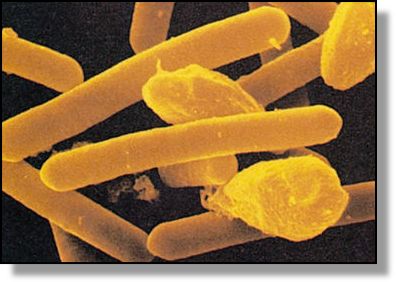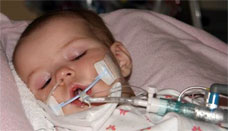Botulism

Etiology/Bacteriology
Taxonomy
Domain- Bacteria
Class- Clostridia
Order Clostridiales
Family-Clostridiaceae
Genus- Clostridium
Species C. botulinum
Description
Clostridium botulinum is the bacteria that is responsible for Botulsim. It is a Gram-positive, rod shaped bacterium that is strictly anaerobic and produces neurotoxins that paralyze host muscular junctions. There are 7 types of toxins, A-G, but only 4 of these, A,B,E, and F, have been known to cause disease in humans. The most common toxins in the United States are A,B, and E. Throughout the world, toxin A is most prevalent. All toxins are encoded in the bacterial chromosome except type G which is thought to be plasmid encoded. C. Botulinum is only able to produce its toxin during sporulation. The endospores can lie dormant for several years in contaminated foods but will become active once the environmental conditions are favorable. Since the bacteria are obligate anaerobes there should be minimal oxygen present and the pH should be low, in the range of 4.8-7. Due to its specific living conditions, it is difficult to grow in the lab. A media culture of tryptose sulfite cycloserine growth media is used the lab setting and there is <2% oxygen in its surrounding area. The bacterium is unable to use lactose as a source of carbon which is a critical biochemical identification when differentiating the organism from other species.
Pathogenesis
C. botulinum secretes one of the most powerful biological toxins. The durability of the spores makes it difficult to kill off the pathogen before it enters the host. The spores are heat and acid resistant so they are able to lie dormant in most environments for long periods of time. Pressure sterilization is one way to kill spores. If the spores are not killed they will germinate in uncooked food and produce toxin. The toxin can be denatured by heat for a specific time period, but if the food is not properly prepared, it can be ingested. Once inside the body, the spores and toxins travel to the intestinal tract. Both are able to pass through the high acidity of the stomach without any complications. The neurotoxin is not inactivated by gastric acid or proteolytic enzymes. For infant botulism, the bacteria and toxin enter the body through a food source. Wound botulism bacteria enter the body through a breach in the skin. Once a physical or chemical barrier has been broken the toxin is absorbed into the blood and circulates the body. Sometimes the bacteria are able to colonize in the intestinal tract and produce neurotoxin. In the majority of cases, the toxin is absorbed by the upper intestinal tract in the duodenum and jejunum. The toxin finds its way to peripheral nervous system through the circulatory system and inhibits motor neurons. Once the neuron is compromised by the toxin the cell cannot secrete acetylcholine. The axon is impaired and the nerve is unable to function. The insertion of the neurotoxin is referred to as an intoxication rather than an infection in the cell. In some cases, the toxin can spread to the central nervous system but it is fairly rare. Once the neurotoxin has been released in the body it acts on neuromuscular junctions where cholinergic blockade occurs and the individual experiences the beginning of paralysis. Symptoms such as weakness, dizziness, dry mouth etc. can occur as soon as 18 hours after an infection.
Transmission

C. botulinum can be transmitted through home canned foods, poorly packaged preserved foods, open wounds, injections, and honey products. Since spores can be dormant for several years canned foods are highly susceptible for contamination. This bacterium, however, is not spread from person to person. Processed foods such a green beans, corn, and beets are some of the most common infected canned foods because of their low acid content which creates a favorable environment for the spores to germinate and create toxin. Other foods such a fish and commercially processed foods can be contaminated but are less common relative to home canned products. Wound injuries can occur when there is a cut on the body that is then exposed to C. botulinum spores. The spores germinates in the would and begins to produce toxins which are absorbed into the blood stream. The toxins are then able to use the host's circulatory system to deliver and infects neuron cells throughout the body. Wound injuries can occur from cuts on the body or drug related injections. The most common drug associated with Botulism is Black Tar Heroin from Mexico. This has been a growing concern because the drug can be exposed to spores. When injected into the body, germination and relocation occur and begin infecting the host with toxin. Infant botulism occurs when a baby under the age of 1 year eats contaminated foods such as honey. The spores are consumed by the baby and they travel to the gasterointestinal tract where they are able to germinate.
Infectious dose, incubation, and colonization
One reason Botulism is so toxic is due to its low infectious dose. It only takes 75 mg of toxin to kill a 75 kg person or 1 mg/1 kg weight of an individual. The incubation period can last for years because of the spores resistance to heat and relatively low acidities. Once the optimal acidity and environmental conditions are right, the spore germinates in food or the host and begins to produce toxin. Colonization can occur at the site of infection like a wound. Less common are colonies of the intestinal tract. Since the toxin is produced in the tissues the bacteria grow near blood vessels so the toxins can be absorbed easily into the blood.
Epidemiology
While the Botulism toxin is one of the most deadly found in nature, it does not infect large numbers annually relative to many other deadly diseases. Between 1990-2000 there were 263 individual cases of foodborne botulism where most of the cases occurs in areas of Alaska. For the United States, average of 25 cases of Botulism each year are reported. The death toll for the disease has dramatically decreased to about 15% per year. For infant botulism, there have been over 500 reported cases since 1976 when it was first described.
Virulence factors
The most detrimental and only virulence factor C. botulinum has is its neurotoxin. It targets the peripheral nervous system and has similar functions to that of the tetanus toxin. The Botulinum toxin is synthesized as a single peptide chain by the organism. It is secreted and absorbed into the blood stream. As a single chain it has little effectiveness. The chain is however cut by a protease into two sections, a light chain and a heavy chain. The chains are connected by disulfide bonds and have different functions. The light chain is the most toxic portion of the peptide, and many argue that it is the most potent toxin found in nature. The heavy chain controls binding to the presynaptic receptors on a nerve cell. The carboxyl terminus of the heavy chain expresses a binding region for the toxin where as the amino terminus creates a channel through the membrane of the neuron cell for the light chain to enter through. The light chain is endocytosed and intoxicates the cell. Proteolytic cleavage of the synaptobrevin II which is found in synaptic vesiclesand causes inhibition acetylcholine secretion. Without acetylcholine, the neuron cannot function properly and paralysis occurs. Once damage from the toxin affects the synapse through vesicle cleavage, it is deemed useless. There is no known mechanism in regards to preventing the secretion of acetylcholine but some studies suggest that the toxin is a zinc dependent endopeptidase that cleave specific proteins in neurotransmission.
Clinical features
After the spores are ingested or a wound is exposed to C. botulinum symptoms start to occur 18-36 hours from the initial infection. Symptoms include weakness, dizziness, constipation, nausea, vomiting and dry mouth. While many of these symptoms are common with many other diseases, more tests are necessary to rule out other possibilities. The toxin's main focus is on the nervous system and the neurological symptoms with the disease include blurred vision, dilated pupil, inability to swallow, speech impairment, urinary retention, respiratory paralysis and skeletal weakness. A series of tests are required to confirm the toxin in the body and treatments are scheduled according to the toxin type and duration of the infection.
Diagnosis
The major indication of Botulism is signs of muscle weakness and/or paralysis. Droopy eyelids and a weak voice can also be factors but are not major signs since they can be mistaken for other diseases. Examination of recent foods consumed can be used to determine a toxin. For wound cases, the cut is checked for any exposure to the bacteria. Infant botulism is determined by the food intake, which honey can be a big factor. For all cases, analysis of blood, stool, or vomit can be used to indicate any traces of toxin. Myasthenia gravis has similar symptoms to Botulism and can be ruled out with tests such as a brain scan, spinal fluid exam, nerve conduction test, and tensilon test. Mice are most commonly used as test subjects. Samples from a patient can be injected into a mouse and examined for the presence of toxin.
Treatment

If caught early, Botulism can be treated with an antitoxin which controls the action of neurontoxin circulating in the blood. This antitoxin is highly effective against type A, B, and E. While the antitoxin can prevent the disorder from becoming worse, it does not completely cure the individual. Physicians use vomiting and enemas as a way to remove any contaminated foods from the body. Paralysis may last several weeks and recovery in the hospital can take a long time. Intensive doctor and nurse care is necessary while the paralysis heals. Muscle therapy is needed as the paralysis improves over time. A breathing machine may be necessary if the respiratory tract is unable to perform properly. Overtime the axon of the nerves are able to regenerate increasing movement function but this can take up to months to recover. For infant botulism, BabyBIG (Botulism Immuno Globin) can be administered to babies.
Prevention
Botulism can be prevented if careful measure are used in canning and processing foods. Strict hygienic procedures should be followed when home canning foods. Other items such as oils with garlic or herbs have been known to contain traces of spores so keep these refrigerated. Cooking food throroughly is highly suggested. The neurotoxin can be destroyed at 85 degrees Celcuis after 5 minutes so boiling of canned products for at least 10 minutes is highly recommended. Bulging cans and other abnormal smelling foods should not be tasted but rather thrown away immediately. Honey should not be fed to babies under 1 year of age. Wound botulism can be prevented by treating wound immediately and avoiding injectable street drugs.
Host Immune Response
When the Botulism toxin is produced, antibodies bind and recognize a foreign substance in the host bodies. Most of the antibodies that distinguish the neurotoxin consists of IgG and IgM. Both of these antibodies initiate opsonization which coats the pathogen for phagocytosis by a leukocyte. Once the toxin has penetrated a nerve cell, the adaptive immune system begins to target intracellular antigens.
References
1 Conway, Tyrrell. “Genus conway”. “Microbe Wiki” 2013. Volume 1. p. 1-2.
Created by Naomi Quillin, student of Tyrrell Conway at the University of Oklahoma.
